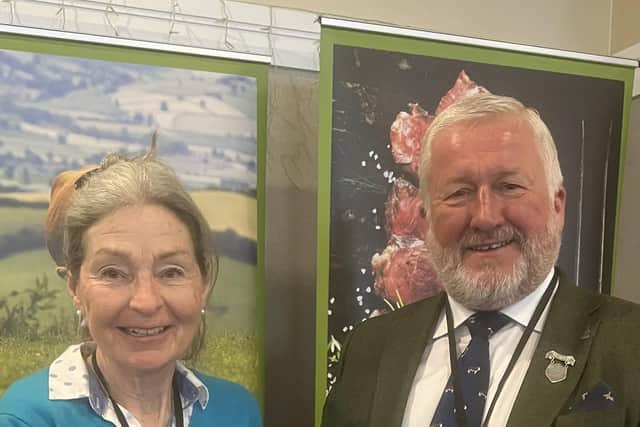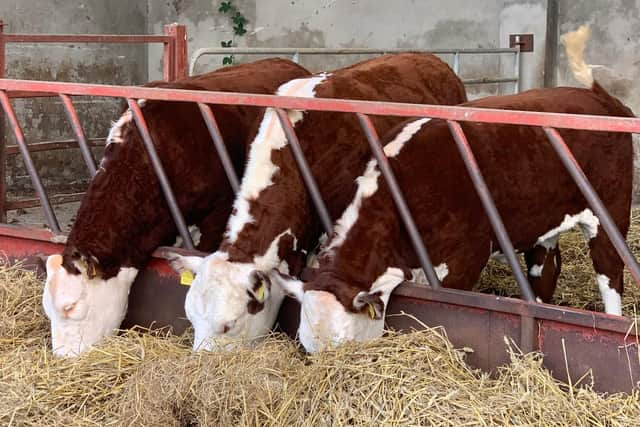Northern Ireland is home to the new Hereford Cattle Society president
and live on Freeview channel 276
He becomes only the sixth person from Northern Ireland to hold the position.
A pedigree breeder of some 20-years standing, Smyth takes on the presidency of the society at a time when demand for Hereford beef is significantly on the rise.
Hereford cattle numbers continue to increase.


Advertisement
Advertisement
This trend is reflected in the quantity of Hereford straws sold by cattle breeding businesses and the number of pedigree breeders now on the ground.
Significantly, AI Hereford usage is in equal demand across both the dairy and suckler sectors.
“This trend is being replicated across the UK and Ireland at the present time,” said Smyth
“Driving this demand is the growing recognition that the Hereford breed ticks every box when it comes to producing beef of the highest quality in the most efficient way possible.”


Advertisement
Advertisement
David Smyth comes to his new position with a wealth of experience. He has a very strong background in financial services and brings a very professional approach to every challenge that confronts him.
Over many years, he has worked closely with, and for, Hereford breeders at both a local and national level.
His interest in Hereford cattle straddles two fundamental parameters.
The first is an absolute passion for the heritage of the breed.
Advertisement
Advertisement
But more than this Smyth believes that Herefords can deliver a real solution for agriculture as the industry faces up to the challenge of climate change and the need to secure higher levels of sustainability.
“One goes hand-in-hand with the other,” he explained.
“I took on the role of society president on January 1st. Prior to that, I had held the position of vice president.
“In addition, I have represented Northern Ireland on the council of the Hereford Society for the past 12 years.”
The Co Down man has also been centrally involved with the Northern Ireland Hereford Breeders Association over a long period of time.
David is the driving force behind Magheraknock Herefords.
Advertisement
Advertisement
“I bought my first heifers in March 2003. My father had died a couple of months prior to this and I made the decision to take the farm in a new direction,” he commented.
“The herd is named after the town land in which the farm is located.
“Today, there are 30 cows in the herd with around 70 followers at different ages.”
David could have gone down the road of selecting any breed upon deciding to go down the pedigree route. But he had a very specific reason for choosing Herefords.
“I always like the look of them,” he said.
Advertisement
Advertisement
“This may not be a very technical decision. But it turned out to be the right one.
“The first two heifers were brought back to the home farm.
"I subsequently bought more land, which has allowed me to build up the herd numbers to where we are today.”
The new society president is quick to confirm that his involvement with the breed has coincided with a more than healthy increase in Hereford numbers – at both a pedigree and commercial level.
He explained:“Numbers have grown dramatically over the past 20 years.
Advertisement
Advertisement
"Here in Northern Ireland, I coordinated a number of Hereford beef schemes.
“These have incentivised farmers to keep more Hereford cattle. In fact, all of the local beef processors are operating some form of Hereford programme.
“However, it’s important that we get the price premia available for certified Hereford beef further strengthened.
“In England, the society is currently involved with a Hereford-focussed sustainability project.
Advertisement
Advertisement
“The scope to further develop the Hereford brand is immense.”
According to Smyth, the consumer-related benefits of Hereford beef and the need to drive up sustainability levels across agriculture as a whole are fundamentally related issues.
“Promoting Hereford beef in this context is a now priority for the society,” he stressed.
“Hereford cattle are renowned for the quality of the beef they produce.
Advertisement
Advertisement
"However, they are also extremely efficient, when it comes to converting feed into liveweight gain.
“The society is specifically following a green theme, where Hereford cattle are concerned.
“In other words, if consumers are eating beef then it should be of the highest quality and produced in the most environmentally friendly way possible.
“Hereford cattle are proven to use feed, grass and forage in an extremely efficient manner.”
Advertisement
Advertisement
Given the current climate, which sees farmers buying fertiliser and other inputs at extremely high prices, David Smyth believes strongly that the conditions are right to secure further inroads for Hereford cattle within the beef sector as a whole.
“The facts speak for themselves,” he stressed.
“Hereford cattle require less feed, grazed grass and silages to reach their finishing weights.”
Smyth is very conscious that cattle prices are currently at record levels.
“But this is where they need to be,” he said.
“In fact, I would argue that they should be even higher. Fertiliser prices have trebled over the past 24 months. Feed prices have increased two-fold in the same period while all the other costs incurred by farmers have increased significantly.
Advertisement
Advertisement
“As a result, beef producers need a significant hike in the cattle price, simply to keep their heads above water.”
According to David Smyth, the number of pedigree Hereford breeders is increasing across the UK.
“Every council meeting sees the ratification of new breeders,” he confirmed.
“In my own case, I have continued to sell a significant number of bulls over the last number of years.
Advertisement
Advertisement
"But heifer sales to newly established herds have been particularly strong during the same period.
“And this is all very promising for the Hereford breed across the board.”
Northern Ireland is a microcosm of what is happening within the Hereford breed nationally.
Back in 1996, the province was home to 30 active, pedigree breeders. Today, that figure has grown to approximately 200.
Advertisement
Advertisement
The new Herford Society president has a number of priorities, which he wants to see addressed during his year in office.
The first of these is the promotion of Hereford bulls as the terminal sires of choice in both suckler and dairy herds.
He further explained:“We need to develop a market for Hereford bulls. This will put more Hereford beef onto retail shelves, which brings us back to the absolute priority of effectively marketing the Hereford brand.
“Moving forward, it should be possible to keep three Hereford-bred cattle than a continental-cross.
Advertisement
Advertisement
“This is the key message that we must communicate to suckler farmers.
"Herefords will mature faster and will leave a better bottom line.”
Reflecting on his own herd development priorities, Smyth said that Hereford bulls must add to farmer’s bottom line when used in a commercial environment.
“Easy calving is crucially important,” he continued.
“Ninety per cent of my bulls are used in dairy herds. If their progeny are not easy calved, I won’t get the follow-up sale.
Advertisement
Advertisement
“Repeat customers are vitally important for all pedigree breeders. Easy fleshing is another attribute of the bulls that I sell.
“And, of course, a Hereford bull will always mark its progeny. The famous white face is a global characteristic of the breed.”
Calving gets underway at Magheraknock Herefords during the third week of March and continues through until the first week of May.
“I have a key landmark date in the year: the day of Saintfield Show. This year, the event takes place on Saturday, June 17th. And that’s the day on which the bull will go out with the cows,” David explained.
Advertisement
Advertisement
“The calves stay with the cows all summer. They are subsequently weaned at the end of October with the bulls separated from the heifers.
“Housing then follows, at which stage all the breeding females are scanned. Any found not to be in calf at that stage are moved on.
“I have traditionally put a stock bull out with the cows. I am currently using Border Sentinel, from the Herefordshire herd of Stan Quan.
“The bull was bought as a weanling. His second crop of calves is due this year. I was very impressed with those born in 2022.
“So, let’s hope that the year ahead will be as successful.”
Advertisement
Advertisement
David has had his fair share of show success and accompanying accolades over the years. But the animal that gave him the greatest degree of satisfaction was a Llancillo Hall heifer, purchased at a Hereford sale 15 years ago.
“The main plan for the day in question was to buy a new stock bull,” he said.
“While I was there, the decision was made to buy a heifer, as much to accompany the new bull on the way home.
“It turned out to be one of the best decisions I ever made. The animal in question remained in the herd for many years and was selected as the Champion Hereford Female of the Year in Northern Ireland on four occasions.”
Advertisement
Advertisement
David Smyth firmly believes that the UK beef sector must be adequately supported by government.
“Farmers cannot rely on the market alone,” he stressed.
“Yes the recent uplift in beef prices is welcome. But they cannot be guaranteed into the future.
“Beef farming requires a long term investment on the part of the farmers involved. They need a degree of economic stability to allow this happen.
“This is why it is so important for government to recognise these realities.”
Advertisement
Advertisement
The New Hereford Cattle Society president is looking forward to the year ahead. But he fully recognises that it will be a very busy one.
“My plan is to attend as many shows and breed events as possible,” David Smyth declared.
“It’s important for me to meet individual breeders. But this goes hand-in-hand with a commitment to continuously promote the values of Herford beef to the general public.
“The Hereford Beef brand represents a tremendous asset for all our breeders. But it must be built upon. And it’s a fundamental part of my job to ensure this happens.”
Advertisement
Advertisement
He concluded:“It is a tremendous honour for me to have been selected as president of the Hereford Cattle Society.
“I am following in the footsteps of so many breeders, who have been so influential in developing the footprint of Hereford cattle within the beef industry.
“The Hereford Cattle Society has a great story to tell. And it’s my job to make sure this momentum is built upon.”
About the breed: The Hereford does it all, whether that’s in the dairy herd, as a terminal sire or suckler cow, these adaptable cattle can work for you. The Hereford is recognised across the world as an efficient, hardy and productive animal, which produces superior beef.
Advertisement
Advertisement
Herefords are the sire of choice for many dairy farmers, having been tried and tested for generations. Good fertility, ease of calving and longevity means you get value out of your bull.
The breed is equally well-suited to any commercial suckler herd as either a terminal sire, or suckler cow. Continental suckler herds are increasingly turning to the Hereford to save management time and with less reliance on the feed bag.
Hereford Beef is recognised around the world for being a cut above the rest and can be enjoyed either as a mid-week staple, or as the centre stage piece when catering for a special occasion or celebration.
Hereford cattle are responsible for superb beef and are one of the oldest and greatest beef breeds in Britain. They love grazing green pastures in the countryside and it is their appetite for the grass which makes Hereford Beef taste even better.